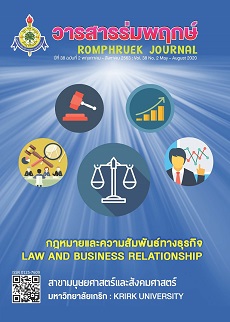The Analysis of Second Tier City’s Readiness for Decision Making of MICE Events in Thailand : Viewpoints of Stakeholders in Central, Northeastern and Southern regions
Main Article Content
Abstract
The objectives of this research were 1) To analyse the readiness of second-tier city for being venue of MICE events in Thailand and 2) To study factor of city’s readiness that affects MICE events’ decision making in the second-tier city. The study was based on questionnaire surveys collected from 119 MICE stakeholders, by using purposive sampling method. Research instrument used the systematic literature reviews, questionnaire, statistics for data analysis by frequency, percentage, mean, standard deviation, exploratory factor analysis and multiple regressive analysis accordingly. The study revealed that 1) Factors affecting the readiness of second-tier city consisted of 9 factors : City’s capabilities and supports Demand & supply Venue and accommodation Process of event promotion Facilitation from governments Infrastructure Services and benefit to community Business opportunities and Offering equipments & information technology by venue 2) The factor influencing the highest level of decision making towards MICE events in second-tier city are The factor of venue and accommodation. and The factor of Infrastructure accordingly.
Article Details
Every article published in the Romphruek Journal of the Humanities and Social Sciences is the opinion and point of view of the authors. Thery're not the viewpoint of Krirk University or the editored department. Any part or all of the articles for pablication must be clearly cited.
References
กรมการท่องเที่ยว. (2561). ท่องเที่ยวเมืองรองลดหย่อนภาษีได้. (20 เมษายน 2563). สืบค้นจาก https://www.dot.go.th/content-sharing/content-sharing-detail/4.
กฤษณ์ คงเจริญ และ มนตรี โสคศิยานุรักษณ์. (2561). การวิเคราะห์ความคุ้มค่าทางด้านเศรษฐศาสตร์และความเสี่ยงในการลงทุน โครงการไฟฟ้าพลังงานขนาดเล็ก โดยใช้วิธีการวิเคราะห์ References Class Forecasting และ Carlo Simulation. วารสารวิชาการบริหารธุรกิจ สมาคมสถาบันอุดมศึกษาเอกชนแห่งประเทศไทย, 7(2), 138-154.
ดุษฎี ช่วยสุข. (2558). การพัฒนาศักยภาพอุตสาหกรรมไมซ์ในจังหวัดขอนแก่นเพื่อรองรับการเป็นไมซ์ซิตี้ของประเทศไทย. วารสารการบริการและการท่องเที่ยว, 10(1), 15-29. นงค์นิตย์ จันทร์จรัส. (2556). การเงินธุรกิจ. (พิมพ์ครั้งที่ 1). ขอนแก่น : มหาวิทยาลัยขอนแก่น.
นิโรธ เดชกำแหง และ ธีระวัฒน์ จันทึก. (2559). รูปแบบการจัดการคุณภาพ ในธุรกิจการจัดงานแสดงสินค้าใน ประเทศ ไทย. วารสารเวอร์ริเดียน อีเจอร์นัล, 9(2), 69-81.
ประภัสสร์ เทพชาตรี. (2559). ประเมินผลกระทบต่อยอดอุตสาหกรรมไมซ์ไทยจากการเข้าสู่ประชาคมเศรษฐ -กิจอาเซียน (AEC). (15 กุมภาพันธ์ 2563) สืบค้นจาก http://dspace.library.tu.ac.th:8080/handle/6626133120/328?locale-attribute=th.
ปาจรีย์ ชัยชุมพล. (2558). รูปแบบสถานที่จัดงานที่เหมาะสมกับการเป็นเมืองแห่งไมซ์ของอำเภอหาดใหญ่ จังหวัดสงขลา. คณะบริหารธุรกิจ มหาวิทยาลัยสงขลานครินทร์, สงขลา.
เพชรลัดดา เพ็ชรภักดี. (2562). ปัจจัยที่มีผลต่อความเมืองอันดับสองในภาคตะวันออกเฉียงเหนือ. วารสาร สังคมศาสตร์ มหาวิทยาลัยศรีนครินทรวิโรฒ, 21(2), 159-173.
เสรี วงษ์มณฑา และ วิชยานันท์ พ่อค้า. (2560). แนวทางการเสริมสร้างศักยภาพของประเทศไทยให้เป็นเมืองเป้าหมายของไมซ์ (MICE). วารสารมนุษยศาสตร์ปริทรรศน์ คณะมนุษยศาสตร์ มหาวิทยาลัยศรีนครินทรวิโรฒ, 39(1), 96-112.
สำนักงานคณะกรรมการพัฒนาสังคมและการเศรษฐกิจแห่งชาติ. (2561). ยุทธศาสตร์ชาติ 20 ปี พ.ศ. 2561 – 2580. (1 ธันวาคม 2562) สืบค้นจาก https://www.nesdb.go.th/download/document/SAC/NS_SumPlanOCT 2018.pdf.
สำนักงานส่งเสริมการจัดประชุมและนิทรรศการ (องค์การมหาชน). (2557). คู่มือการประเมินและคัดเลือกเมือง เพื่อจัดประชุมองค์กร การท่องเที่ยวเพื่อเป็นรางวัล การประชุมวิชาการ การแสดงสินค้า (MICE City). กรุงเทพฯ : สำนักงานส่งเสริมการจัดประชุมและนิทรรศการ (องค์การมหาชน).
สำนักงานส่งเสริมการจัดประชุมและนิทรรศการ (องค์การมหาชน). (2561). รายงานประจำปีงบประมาณ 2561. (2 ธันวาคม 2561) สืบค้นจาก https://www.businesseventsthailand.com/files/annual-reports/TCEB-AR2018-JULY07.pdf.
Armstrong, G., Adam, S., Denize, S.M., Volkov, M. & Kotler, P. (2014). Principles of marketing. Malaysia : Pearson
Australia Group Pty Ltd. Bornhorst, T., Ritchie, J. B., & Sheehan, L. (2010). Determinants of tourism success for DMOs & Destinations : An empirical examination of stakeholders' perspectives. Tourism manage- ment, 31(5), 572-589.
Crouch, G. I., Del Chiappa, G., & Perdue, R. R. (2019). International convention tourism : a choice modelling experiment of host city competition. Tourism Management, 71, 530-542.
García, J. A., Gómez, M., & Molina, A. (2012). A destination-branding model : an empirical analysis based on stakeholders. Tourism management, 33(3), 646-661.
Jin, X., & Weber, K. (2016). Exhibition destination attractiveness–organizers’ and visitors’ perspectives. International Journal of Contemporary Hospitality Management, 28(12), 2719-2819.
Jitpleecheep, P. (2019). Nielson Identifies Second-Tier City as New Growth Driver. (December 1, 2019). Retrieved from https://www.bangkokpost.com/business/1709171/nielsen-identifies-second-tier-cities-as-new-growth-driver. Kotler, P. (2003).
Marketing management. New Jersey : Prentice-Hall. Porter, M. E. & Porter, M. P. (1998). Location, Clusters, and the "New" Microeconomics of Competition. Business Economics, 33(1), 7-13.


